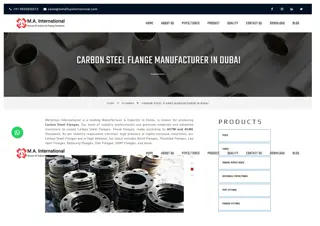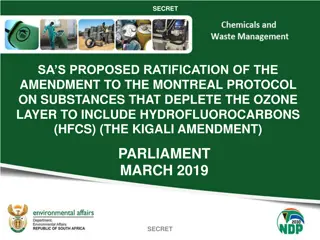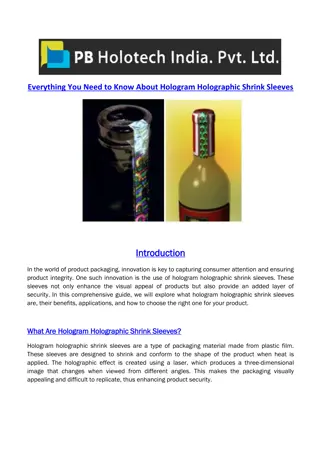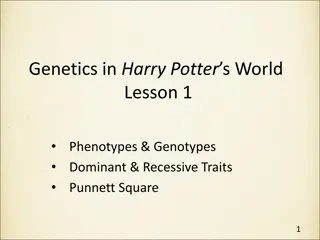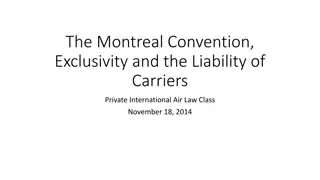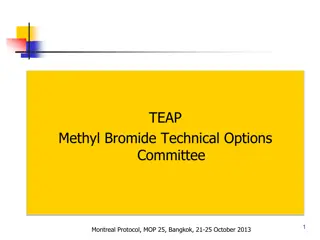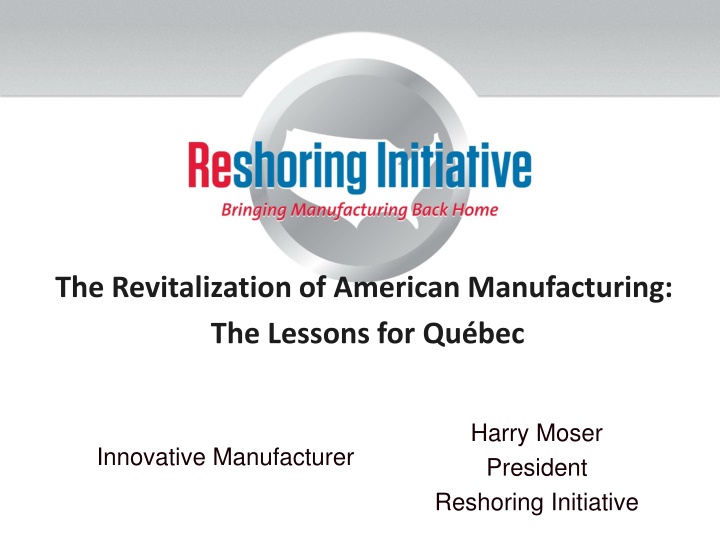
American Manufacturing Revitalization Lessons and Recent Trends
Explore the lessons learned and recent trends in American manufacturing since WWII, including the impact of offshoring, reshoring initiatives, and the vision of Donald J. Trump. Discover how factors like rising Chinese wages, Industry 4.0, and consumer preferences for "Made in USA" are shaping the future of manufacturing in the U.S.
Download Presentation

Please find below an Image/Link to download the presentation.
The content on the website is provided AS IS for your information and personal use only. It may not be sold, licensed, or shared on other websites without obtaining consent from the author. If you encounter any issues during the download, it is possible that the publisher has removed the file from their server.
You are allowed to download the files provided on this website for personal or commercial use, subject to the condition that they are used lawfully. All files are the property of their respective owners.
The content on the website is provided AS IS for your information and personal use only. It may not be sold, licensed, or shared on other websites without obtaining consent from the author.
E N D
Presentation Transcript
The Revitalization of American Manufacturing: The Lessons for Qu bec Harry Moser President Reshoring Initiative Innovative Manufacturer
My Long-Term Overview re U.S. Mfg. Since WWII: World policeman Opened market to help countries stabilize and democratize Sacrificed its manufacturing for diplomacy Target market for ROW s exports Currency too high due to reserve and safe haven status Poor basic education, training, tax policy Short-sighted corporate strategies and sourcing policies Result: Cumulative trade deficits since 1980: $11T, ~ 50% of NYSE value Budget deficits, mfg. employment, income inequality Most of mfg. job loss is due to offshoring
Relevant Recent Trends BTE Tailwinds: Chinese wages rising rapidly Industry 4.0 Consumer preference for Made in USA Lean/Increasing recognition of the costs and risks of offshoring Walmart Globalization & trade deficit plateaued / Localization growing Headwinds: USD 30% too high vs. most currencies Oil price low ROW slow
The Bleeding had Stopped Manufacturing Jobs/Year 2000-2003 Annual Average ~240,000 2015 % Change New Offshoring New Reshoring & FDI Net Jobs Gained ~60,000 -75% 12,000 67,000 + 400% ~-220,000 ~0 N/A 4
What Happens ATE? Donald J. Trump s Vision: Negotiate fair trade deals that create American jobs, increase American wages, and reduce America's trade deficit. Actions: Ford/Apple/Carrier, TPP, etc. Plans: NAFTA, China Reduced corp. tax rates & regulations Repatriate $Ts BAT or tariffs Companies: U.S. or delay. (BLS) , +100% (RI)
NAFTA USTR 3/30/17 Greater flexibility to impose/reinstate tariffs Stronger rules for labor/environment WH 3/31/17 USTR statement: Is not a statement of administration policy Misses currency disputes & trade deficit reduction targets Seeks authority to re-impose tariffs, protect at risk industries Calls for: Leveling the playing field in tax treatment Expanding opportunities for agriculture Strengthening rules of origin
The Industry-Led Reshoring Initiative Provides Online Library of 4,000+ reshoring articles Statistics from TCO and Library databases Case Study template for posting cases. Motivation for skilled manufacturing careers Free Total Cost of Ownership (TCO) software for: Companies for sourcing Suppliers of parts and equipment for selling
TCO cases, China vs. U.S. Comparison Basis % of cases where U.S. has the advantage 5% 53% 48%* Price TCO Difference *Conservatively 25% might return if companies shifted to TCO Source: TCO user database
Circuit Boards morey_logo Woodridge, IL Supplies heavy equipment companies Had quality issue with a Chinese component Found local IL source Result: Quality problem fixed Inventory cut by 94% $60M order 12
Canadian Cases Reshoring FDI Kept From Offshoring
Industry 4.0 Advanced manufacturing favors developed countries: Less labor/unit of output Required labor is higher skilled with smaller % wage difference vs. developing countries More capital intense. Equipment is as or more expensive in other countries due to VATs. Enables fast, customized customer response, impossible from Asia 14
Virtuous Cycle: Reshoring/Productivity Reshoring Capacity Utilization Competitiveness Investment Productivity
Competitiveness Toolkit Factor Model Competitiveness Impact Est. 5%? Skilled Workforce Germany and Switzerland Corp Tax Reform VAT Ireland 2% Most of the World 15%? Focus on reshoring $ Down 30% Japan, China, Korea, Europe Reduce regulations/ health costs UK, Korea, Holland ? 10% - 15% ? ? 16
Predictions/Hopes Skilled workforce: Increased support. Corporate tax rates: 20%, phased in BAT: 15%, phased in Adjust tariff and non-tariff barriers to match ROW Regulatory reform: Psychologically positive impact Infrastructure: Moderate size Healthcare: Focus on cost reduction and then revise ACA
Recommended Corporate Strategy Target imports that cause pain Use TCO to evaluate: 1st Keep existing domestic sources 2nd Shift outsourcing back 3rd Repurpose offshore own-facility to serve the offshore market. Incrementally invest domestically to serve domestic market 4th Shut offshore own facility. Build new domestic facility. If Canada is best or close build here/4.0/train If Canada high by 5 - 20%, delay. If high by 20% nearshore or offshore.
Lessons for Canada Focus on: Manufacturing Import substitution/reshoring/FDI more than exports: TCO Track and promote reshoring. Apply our methods. Develop a Canadian Champion! Increase competitiveness Skilled workforce: Shortages everywhere, esp. U.S. Market Made in Canada BAT or VAT: Match any U.S. action Produce more mining and oil equipment. Team with U.S. and Mexico to bring mfg. back from Asia.
Do the Math. Develop your Strategy! Contact: Harry Moser Founder and President 01-847-726-2975 harry.moser@reshorenow.org www.reshorenow.org Useful links: ACETool Cost Differential Frontier Total Cost of Ownership Estimator Skilled Workforce Economic Development 20
Marketing the Benefits of Reshored Products Key behavioral influences to implement when marketing reshored products: Environmental Impact: Sustainable: reduced shipping and stricter standards improves environmental footprint Local Jobs: Reduces unemployment and supports local families and communities Convenience and Efficiency: Provides more efficient production, flexibility and faster lead times Quality: Made in USA reinforces the message of quality standards, builds brand presence and creates an emotional connection with consumers Source: Traction Digital, The Effects of Reshoring on Purchase Behaviour and How Marketers Need to Keep Pace! , Feb. 2017; https://tractiondigital.com/the-effects-of-reshoring-on-purchase-behaviour-and-how- marketers-need-to-keep-pace/#comments
Quantifying the Competitiveness Gap TCO user database provides: Ex-works product price comparisons User calculated hidden costs including quality, delivery, IP etc. By source country (esp. China) and industry We could: Calculate the % ex-works and TCO competitiveness gaps. Estimate the mix of actions (VAT, corp tax rates, productivity, USD) to reduce the trade deficit by X%.
Digitization Leads to Localization of Supply Chains Source: Industry Week Webinar, Industry 4.0 overview of key application areas and survey findings , Feb. 23, 2017; http://event.lvl3.on24.com/event/13/37/10/8/rt/1/documents/resourceList1487874749267/webinar_presentation .pdf
Trump Targets Trade Abuses with Executive Orders President Trump wants to lower the $502.3 billion (2016) U.S. trade deficit Trump signs 2 executive orders to deter trade abuses Exec Order #1: Identify trade abuse that contribute to the trade deficit Exec order #2: escalate the collection of anti-dumping and countervailing duties, levied against foreign governments that subsidize products so they can be sold below cost Source: Manufacturing.net, Trump To Sign Executive Orders Targeting Trade Abuses , Mar. 31, 2017: http://www.manufacturing.net/news/2017/03/trump-sign-executive-orders-targeting-trade- abuses?et_cid=5896169&et_rid=1020403735&location=top&et_cid=5896169&et_rid=1020403735&linkid=http %3a%2f%2fwww.manufacturing.net%2fnews%2f2017%2f03%2ftrump-sign-executive-orders-targeting-trade- abuses%3fet_cid%3d5896169%26et_rid%3d%%subscriberid%%%26location%3dtop
Reshored & FDId Industries: Top 10 Industry Transportation Equipment Electrical Equipment, Appliances, Components Fabricated Metal Products Plastic/Rubber Products Computer/Electronic Products Apparel/Textiles Machinery Chemicals Wood Products Food & Beverage Jobs 98,232 35,388 20,413 19,507 15,635 13,903 13,561 10,652 9,853 7,417 Sources: Reshoring Initiative Library. Cases 2007 through 12/31/15. 25
Negative Issues Offshore: Top 10 Negative Reasons not to Offshore Companies Quality/rework/ warranty Freight cost Rising wages Total cost, TCO Delivery Inventory Supply chain interruption risk Communications, Intellectual property risk Loss of control 127 100 66 62 51 46 34 30 each 25 26 Source: Reshoring Initiative Library, December 2015.
Positive Reasons to Reshore: Top 10 Positive Reasons to Reshore Lead time/time to market Image/brand Automation/technology (incl. 3D) Government Incentives Walmart Companies 113 87 70 48 42 Re-design of the part, Skilled workforce 41 each Manufacturing/Engineering joint innovation, R&D 36 Higher productivity, Lean 33 each 27 Source: Reshoring Initiative Library, December 2015
Top Countries From Which Reshored Global Region Asia North America Western Europe Eastern Europe Cases Country China Mexico Canada Japan Taiwan Italy India Korea, Malaysia, Hungary Cases 210 33 13 9 7 6 5 2 each 257 46 13 5 28 Source: Reshoring Initiative Library,2010 through 2015.
Manufacturers Optimism at 20 Year High Positive outlook on their companies: March 2017: 93% December 2016: 78% March 2016: 57% Highest in the NAM quarterly survey's 20 year history Source: US News & World Report, Trump Meets With Manufacturing Group , Mar. 31, 2017; https://www.usnews.com/news/business/articles/2017-03-31/trump-meets-with-manufacturing-group; Industrial Info Resources, Survey: U.S. Manufacturers Predict More Capital Spending , Mar. 31, 2017; http://www.industrialinfo.com/news/article.jsp?newsitemID=257139&qiSessionId=9E4085AA1B9EC05B5D E47EB76557B914.goose
We are beating the trend BLS Manufacturing Employment 000's 20000 18000 Historical 16000 Current 14000 Expon. (Historical) 12000 10000 8000 6000 1997 1999 2001 2003 2005 2007 Year 2009 2011 2013 2015
Reshoring More Effective than Exporting: Canada is Much More Competitive at Home! Where Sold Canada China Where Made Canada $100 China $115 $85 $100 Difference 0 30% Based on TCO being 15% higher for exports









